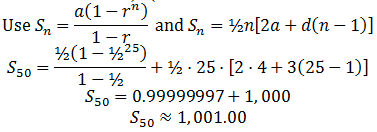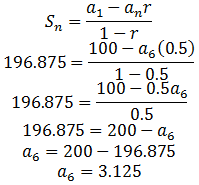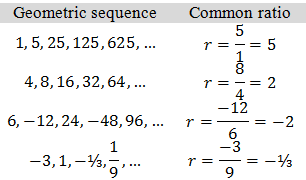We shall now move on to the other type of sequence we want to explore.
Consider the sequence
Here, each term in the sequence is 3 times the previous term. And in the sequence
each term is -2 times the previous term. Sequences such as these are called geometric sequences.
Let us write down a general geometric sequence, using algebra. We shall take a to be the first term, as we did with arithmetic sequences. But here, there is no common difference. Instead there is a common ratio, as the ratio of successive terms is always constant. So we shall let r be this common ratio. With this notation, the general geometric sequence can be expressed as
So the n-th can be calculated quite easily. It is ar(n-1), where the power (n-1) is always one less than the position n of the term in the sequence. In our first example, we had a=2 and r=3, so we could write the first sequence as
In our second example, a=1 and r=-2, so that we could write it as
Key Point
A geometric sequence is a sequence where each new term after the first is obtained by multiplying the preceding term by a constant r, called the Common ratio. If the first term of the sequence is a then the geometric sequence is
a, ar, ar2, ar3, … .
where the n-th term is ar(n-1).
Example 1. In a geometric sequence, the fifth term is 80 and the common ratio is -2. Determine the first three terms of the sequence.
a5=ar4=a⋅(-2)4=80
16a=80
a=5
∴a1=5, a2=5⋅(-2)1=-10, a3=5⋅(-2)2=20
Example 2: Creating a Geometric Sequence
Write the sequence in which
answer:
a2=ar=5(3)=15
a3=a2 r=15(3)=45
a4=a3 r=45(3)=135
a5=a4 r=135(3)=405
Therefore, the required sequence is 5, 15, 45, 135, 405.
Write terms of a geometric sequence.
Example 3: Writing the Terms of a Geometric Sequence
Write the first six terms of the geometric sequence with first term 6 and common ratio ⅓.
Solution:
The first term is 6. The second term is 6⋅⅓, or 2. The third term is 2⋅⅓, or ⅔. The fourth term is ⅔⋅⅓, or 2/9, and so on. The first six terms are
The General Term of a Geometric Sequence
Consider a geometric sequence whose first term is a1 and whose common ratio is r. We are looking for a formula for the general term, an. Let’s begin by writing the first six terms. The first term is a1. The second term is a1⋅r. The third term is a1 r⋅r, or a1⋅r2. The fourth term is a1⋅r2⋅r, or a1⋅r3, and so on. Starting with a1 and multiplying each successive term by r, the first six terms are

Can you see that the exponent on r is 1 less than the subscript of a denoting the term number?

Thus, the formula for the nth term is

General Term of a Geometric Sequence
The nth term (the general term) of a geometric sequence with first term a1 and common ratio r is an=a1⋅r(n-1).
Study Tip
Be careful with the order of operations when evaluating a1⋅r(n-1).
First find r(n-1). Then multiply the result by a1.
You have seen that each term of a geometric sequence can be expressed in terms of r and its previous term. It is also possible to develop a formula that expresses each term of a geometric sequence in terms of r and the first term a1. Study the patterns shown in the table on the next page for the sequence 2, 6, 18, 54, … .

The three entries in the last column of the table all describe the nth term of a geometric sequence. This leads us to the following formula for finding the nth term of a geometric sequence.
Key Concept: nth Term of a Geometric Sequence
The nth term an of a geometric sequence with first term a1 and common ratio r is given by
an=a1⋅r(n-1).
where n is any positive integer.
Example 4: List the first 4 terms of each geometric sequence and find the common ratio (r).
a) an=2n
Solution:
Each term is a multiple of 2 apart so the common ratio is 2.
Answer: First 4 terms 2, 4, 8, 16 common ratio 2
b) an=3⋅2n
Solution:
Each term is a multiple of 2 apart so the common ratio is 2.
Answer: First 4 terms 6, 12, 24, 48 common ratio 2
c) an=½n
Solution:
Each term is a multiple of ½ apart so the common ratio is ½.
Answer: first 4 terms ½, ¼, ⅛, 1/16 and the common ratio is ½.
d) an=23n
Solution:
Each term is a multiple of 8 apart so the common ratio is 8.
Answer: first 4 terms 8, 64, 512, 4096 common ratio 8
e) an=2⋅32n
Solution:
Each term is a multiple of 9 apart so the common ratio is 9. Answer: first 4 terms 18, 162, 1458, 13122 common ratio 9.
Example 5: Writing the terms
Write the first five terms of the geometric sequence whose nth term is
Solution:
Let n take the values 1 through 5 in the formula for the nth term:
a2=3(-2)(2-1)=-6
a3=3(-2)(3-1)=12
a4=3(-2)(4-1)=-24
a5=3(-2)(5-1)=48
Notice that an=3(-2)(n-1) gives the general term for a geometric sequence with first term 3 and common ratio -2. Because every term after the first can be obtained by multiplying the previous term by -2, the terms 3, -6, 12, -24, and 48 are correct.
Example 6. Write down the first four terms of the sequence un=8⋅¾n and show that the sequence is geometric.
Solution:

Thus, un is a geometric sequence.
A geometric sequence has the form
in which each term is obtained from the preceding one by multiplying by a constant, called the common ratio and often represented by the symbol r. Note that r can be pos- itive, negative or zero. The terms in a geometric sequence with negative r will oscillate between positive and negative.
The doubling sequence
is an example of a geometric sequence with first term 1 and common ratio r=2, while
is an example of a geometric sequence with first term 3 and common ratio r=-2.
It is easy to see that the formula for the nth term of a geometric sequence is
an=ar(n-1).
Definition:
A sequence a1, a2, …, an, … is called a geometric sequence. If there exists a constant r, such that
Thus, a geometric sequence looks as follows:
where a is called the first term and r is called as the common ratio of the geometric sequence.
The nth term of the geometric sequence, is given by
Some other examples of geometric sequences are

nth term or General term(or, last term) of a Geometric sequence:
If a is the first term and r is the common ratio then the general form of geometric sequence is
If a1= 1st term =a
a3= 3rd term =ar2
…
an= nth term =ar(n-1)
Which is the nth term of geometric sequence in which:
a= first term
r= common ratio
n= number of terms
an= nth term=last term
Example 7. Determine the first three terms of a geometric sequence whose 8th term is 9 and whose 10th term is 25.

The first three terms of a geometric sequence is:
Example 8. Find a geometric sequence for which sum of the first two terms is -4 and the fifth term is 4 times the third term.
Solution
Let a be the first term and r be the common ratio of the geometric sequence. According to the given conditions,
ar4=4ar2
r2=4 ∴r=±2
a+ar=-4
a(1+r)=-4
For r=2 then a=(-4)÷(1+2)∴a=-4/3. Also
For r=-2 then a=(-4)÷(1-2)∴a=4.
Thus, the required geometric sequence is -4/3, -8/3, -16/3, … or 4, -8, 16, -32, … .
Example 9: Write down the first four terms with the following situation, will the terms be the first four terms of a geometric sequence?
The amount of air present in the cylinder when a vacuum pump removes each time ¼ of their remaining in the cylinder.
Solution:
Given
Let the initial volume of air in a cylinder be V liters each time ¾ of air in a remaining i.e., (1-¼).
First time, the air in cylinder is V.
Second time, the air in cylinder is ¾V.
Third time, the air in cylinder is ¾2 V.
Therefore, the sequence is V, ¾V, ¾2 V, ¾3 V, … .
Clearly, this series is a geometric sequence. With first term (a)=V, common ratio (r)=¾.
Example 10. k-1, 2k, and 21-k are consecutive terms of a geometric sequence. Find k.
Solution:
Equating the common ratio r.

Check: If k=7/5 the terms are: ⅖, 7/5, 98/5. ✓ {r=7}
If k=3 the terms are: 2, 6, 18. ✓ {r=3}





